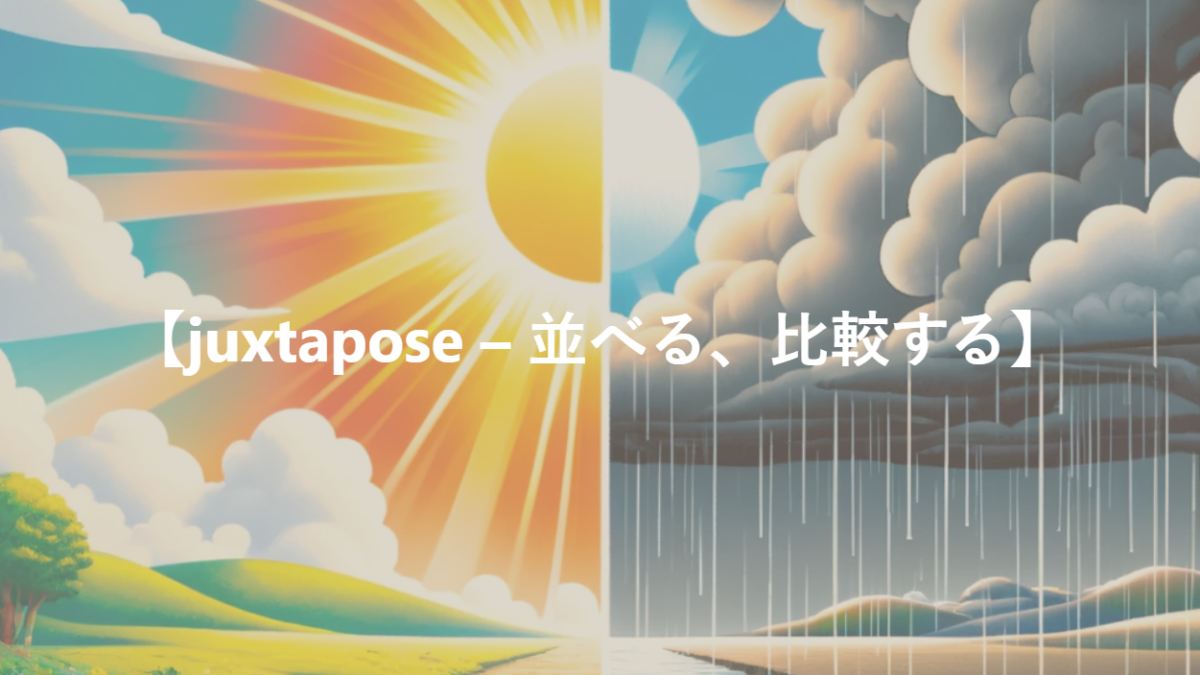語源・類義語・反対語・例文
【juxtapose – 並べる、比較する】という単語の語源とか由来を知っていますか?
「juxtapose」という単語は、フランス語の「juxtaposer」から来ています。これは、「juxta-」(ラテン語で「近く」を意味する)と「poser」(「置く」を意味する)の組み合わせから成り立っています。元々は、文字通りに物事を物理的に隣接させることを指す言葉でしたが、時間が経つにつれて、比較や対比を目的として異なる要素を並べるという意味で広く使われるようになりました。現代では、芸術、文学、写真など多くの分野で、異なる対象、アイデア、イメージを並べて比較し、新たな洞察を引き出すために用いられます。
The word “juxtapose” originates from the French “juxtaposer,” which combines “juxta-” (meaning “close” in Latin) and “poser” (meaning “to place”). Originally, it referred to the act of physically placing things side by side, but over time it has come to be widely used to mean placing different elements together for the purpose of comparison or contrast. Today, it is used extensively across various fields such as art, literature, and photography, to compare and contrast different subjects, ideas, or images, drawing new insights from their proximity.
この単語の類義語・反対語を教えてください。
類義語
- Compare: 比較する。
- Contrast: 対比させる。
- Collate: 照合する。
- Align: 並べる。
- Associate: 関連付ける。
- Pair: 組み合わせる。
- Position side by side: 横に並べる。
反寧語
- Separate: 分ける。
- Isolate: 孤立させる。
- Disconnect: 切り離す。
- Disassociate: 関連を断つ。
- Dissociate: 分離する。
- Scatter: 散らす。
- Disperse: 分散させる。
この単語を使った例文を5つほど教えてください。
The artist juxtaposed vibrant colors with dark tones to create a striking contrast.
(画家は鮮やかな色と暗いトーンを並べて劇的な対比を生み出しました。)
In her speech, the speaker juxtaposed examples from history to illustrate the relevance of the past to the present.
(スピーチでは、講演者が歴史の例を並べて、過去と現在の関連性を示しました。)
The magazine cover juxtaposed images of luxury and poverty, highlighting social inequality.
(雑誌の表紙では、贅沢と貧困のイメージを並べて社会的な不平等を強調しました。)
The documentary film juxtaposes interviews with experts and footage from the event to provide a comprehensive view.
(ドキュメンタリー映画では、専門家へのインタビューとイベントの映像を並べて、包括的な視点を提供しました。)
The writer juxtaposed two conflicting viewpoints in the novel, sparking a thought-provoking debate.
(作家は小説で相反する二つの視点を並べて、考えさせられるディベートを引き起こしました。)
【juxtapose – 並べる、比較する】のコロケーション
- Juxtapose images: 「画像を並べる」。異なる画像や写真を隣り合わせに配置して、対比や関係を視覚的に示します。この技術は特に写真やデザインの分野でよく使用され、新たな視点や意味を生み出すことができます。
- Juxtapose ideas: 「アイデアを比較する」。異なる考えや概念を並べて、それぞれの違いや共通点を明確にします。これにより、より深い理解や新しい洞察を得ることが可能になります。
- Juxtapose themes: 「テーマを並べる」。文学や映画、芸術作品において、異なるテーマやメッセージを対比させることで、作品の複雑さや多層性を強調します。
- Juxtapose characters: 「キャラクターを対比させる」。特に物語や演劇において、性格や背景が異なるキャラクターを並置することで、彼らの違いを強調し、物語のダイナミクスを高めます。
- Juxtapose colors: 「色を並べる」。デザインや芸術において、異なる色を並べて視覚的な対比を作り出します。色の対比は、強い視覚効果を生み出し、作品に感情や意味を加えることができます。
「juxtapose」とは、「並べる」や「比較する」という意味を持つ英単語で、異なる要素を隣り合わせに配置して、その対比や関係性を明らかにするために使われます。この技法は、視覚芸術、文学、写真、デザインなど、多岐にわたる分野で活用されます。
まず、”Juxtapose images”は「画像を並べる」という意味で、写真やアート作品において、異なるイメージを並置することにより、視覚的な比較や対話を生み出す技法を指します。このアプローチにより、見る人に新たな洞察や感情を喚起することができます。
次に、”Juxtapose ideas”は「アイデアを比較する」と訳され、異なる概念や考えを並べて比較することで、それぞれのアイデアの特徴や関係性を明確にすることを意味します。これは、論文や議論、思考実験において特に有効な手法です。
“Juxtapose themes”は「テーマを並べる」という意味で、文学作品や映画、絵画などにおいて、異なるテーマを対比させることにより、作品の深みや多様性を際立たせる手段です。
また、”Juxtapose characters”は「キャラクターを対比させる」という意味で、物語や演劇におけるキャラクター同士を比較し、その相違や相互作用を通じて人物像やストーリーの複雑さを掘り下げます。
最後に、”Juxtapose colors”は「色を並べる」という意味で、デザインやアートにおいて異なる色彩を隣接させることで、強烈な視覚効果や感情的な影響を生み出す技法を指します。色の対比は、作品にダイナミズムや説得力をもたらすことがあります。
“Juxtapose” is an English word meaning “to place side by side” or “to compare,” used to position different elements next to each other to clarify their contrasts and relationships. This technique is utilized across various fields, including visual arts, literature, photography, and design.
Firstly, “Juxtapose images” refers to the method in photography or art where different images are placed side by side to create a visual comparison or dialogue. This approach can evoke new insights and emotions in the viewer.
Next, “Juxtapose ideas” translates to comparing different concepts or thoughts side by side to clarify the characteristics and relationships of each idea. This is a particularly effective method in academic papers, debates, and thought experiments.
“Juxtapose themes” means placing different themes side by side in literary works, films, or paintings, which serves to highlight the depth and diversity of the work.
Moreover, “Juxtapose characters” refers to comparing characters within a story or play, examining their differences and interactions to delve deeper into their personas and the story’s complexity.
Finally, “Juxtapose colors” describes the technique in design or art where different colors are placed adjacent to each other, creating strong visual effects or emotional impacts. The contrast of colors can bring dynamism and persuasive power to a piece.
juxtaposeを使った文法問題
- The artist _____ images of poverty and wealth in his latest exhibition, creating a stark contrast.
- (A) juxtaposed
- (B) juxtaposing
- (C) juxtaposition
- (D) juxtapositional
解答と解説: (A) juxtaposed
解説: 芸術家が並置したのは過去の出来事なので、過去形の juxtaposed が適切です。
- The documentary _____ the lives of two families from vastly different socioeconomic backgrounds.
- (A) juxtaposed
- (B) juxtaposing
- (C) juxtaposition
- (D) juxtapositional
解答と解説: (A) juxtaposed
解説: ドキュメンタリーが2つの家族の生活を並置したのは過去の出来事なので、過去形の juxtaposed が適切です。
- The author’s use of _____ between light and darkness creates a sense of tension and drama in the novel.
- (A) juxtaposed
- (B) juxtaposing
- (C) juxtaposition
- (D) juxtapositional
解答と解説: (C) juxtaposition
解説: 空欄にはuse ofの後に続く名詞が入ります。juxtapositionは「並置、並列」という意味の名詞です。
- By _____ the two historical events, the historian was able to highlight their similarities and differences.
- (A) juxtaposed
- (B) juxtaposing
- (C) juxtaposition
- (D) juxtapositional
解答と解説: (B) juxtaposing
解説: by ~ingで「~することによって」という意味になります。
- The photographer’s work is characterized by her unique ability to _____ seemingly unrelated objects and create a harmonious composition.
- (A) juxtaposed
- (B) juxtaposing
- (C) juxtaposition
- (D) juxtapose
解答と解説: (D) juxtapose
解説: ability to do ~ で「~する能力」という意味になります。to不定詞の後なので動詞の原形であるjuxtaposeが適切です。

